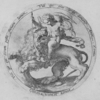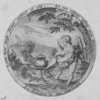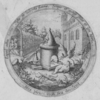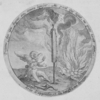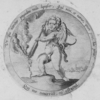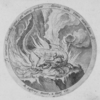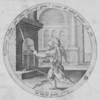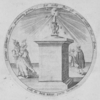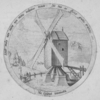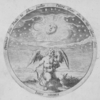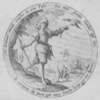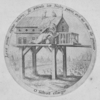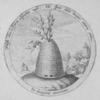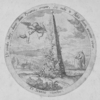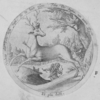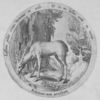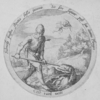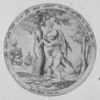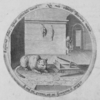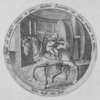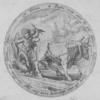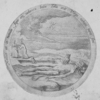Ni mesme la mort [17]
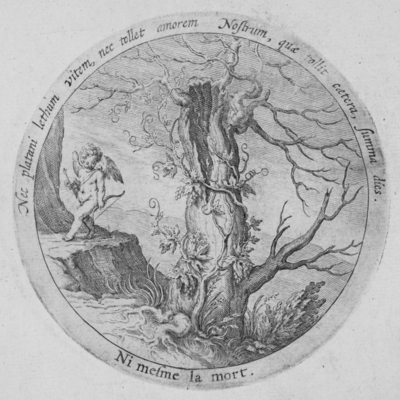
Het een is gantsch vergaen/ het ander staet noch schoone/
End’ spreyt zijn rancken uyt zeer rijckelijck ten toone/
Altijdt zijnd’ even groen/ zoo gaet het oock met dy
O VENVS lieflijck kindt1/ die altijt woont in my.
De doot neemt wech den mensch’ maer laet de liefde leven/
Zy wordt noch door den doodt/ noch door den tijdt Verdreven.
Zy blijft alst al2 vergaet/ zy bloeyt oock in den noot/
De doodt Verwint het al/ maar VENVS3 oock de doodt.
End’ spreyt zijn rancken uyt zeer rijckelijck ten toone/
Altijdt zijnd’ even groen/ zoo gaet het oock met dy
O VENVS lieflijck kindt1/ die altijt woont in my.
De doot neemt wech den mensch’ maer laet de liefde leven/
Zy wordt noch door den doodt/ noch door den tijdt Verdreven.
Zy blijft alst al2 vergaet/ zy bloeyt oock in den noot/
De doodt Verwint het al/ maar VENVS3 oock de doodt.

Translations
 |
Zelfs de dood niet. |
 |
Not even death. |
 |
De dood neemt de wijnrank niet weg van de plataan, en zo neemt de laatste dag, die al het andere wegneemt, onze liefde niet weg. |
 |
Death does not take away the vine from the plane-tree, and thus the last day, that takes away everything else, will not take away our love. |
Literature
-
Henkel and Schöne, Emblemata
 , col. 260
, col. 260
-
Praz, Seventeenth-Century Imagery
 , pp. 96-97
, pp. 96-97
Sources and parallels
- Same emblem in 1608 edition: Ni mesme la mort [17] (in: Daniël Heinsius, Emblemata amatoria (1607/8))
[Compare
![Compare [compare]](/static/images/compare2.gif) ]
]
- Source for the pictura (the emblem carries another message): Alciato, Book of Emblems
 , embl. 160
, embl. 160
-
Parallel in the 1616 edition: motto and subscriptio the same, pictura mirrored and more detailed in the background:
Ni mesme la mort. [43] (in: Daniël Heinsius, Ambacht van Cupido, from: Nederduytsche poemata (1616))
[Compare
![Compare [compare]](/static/images/compare2.gif) ]
]
-
A parallel (and probably adaptation) for the motto, emblem carries another message: Amor, qui desinere potest, numquam verus fuit [93] (in: Otto Vaenius, Amorum emblemata (1608))
[Compare
![Compare [compare]](/static/images/compare2.gif) ]
]
-
A parallel (and probably adaptation) for the entire emblem: Transilit et fati litora magnus amor [123] (in: Otto Vaenius, Amorum emblemata (1608))
[Compare
![Compare [compare]](/static/images/compare2.gif) ]
]
References, across this site, to this page:
- Ni mesme la mort [17] (in: Daniël Heinsius, Emblemata amatoria (1607/8))
- Ni mesme la mort. [43] (in: Daniël Heinsius, Ambacht van Cupido (1613))
- Ni mesme la mort. [43] (in: Daniël Heinsius, Ambacht van Cupido, from: Nederduytsche poemata (1616))
- Amor, qui desinere potest, numquam verus fuit [93] (in: Otto Vaenius, Amorum emblemata (1608))
- Transilit et fati litora magnus amor [123] (in: Otto Vaenius, Amorum emblemata (1608))
Iconclass
A vine is coiled around the remains of a dead elm, with Cupid watching- trees: elm (+ dead, withered plant)
[25G3(ELM)(+371)]

- death of human being
[31E]

- archer's weapons: arrow
[45C15(ARROW)]

- archer's weapons: bow
[45C15(BOW)]

- quiver
[45C23]

- vine (+ bearing fruit)
[47I422(+8934)]

- vine (+ other characteristics of plant growth)
[47I422(+8939)(CLIMBING)]

- Strength, Power; 'Fortezza', 'Fortezza d'Animo e di corpo', 'Fortezza del corpo congiunta con la generosité dell'animo', 'Fortezza
& valore del corpo congiunto con la prudenza & virtù del animo', 'Forza' (Ripa) (+ emblematical representation of concept)
[54A7(+4)]

- (personifications and symbolic representations of) Love; 'Amore (secondo Seneca)' (Ripa) (+ emblematical representation of
concept)
[56F2(+4)]

- 'Forza d'amore, Forza d'amore si nell'acqua come in terra' (Ripa) (+ emblematical representation of concept)
[56F2515(+4)]

- proverbs, sayings, etc. (with TEXT)
[86(NI MESME LA MORT)]

- other non-aggressive activities of Cupid
[92D156]

- attributes of Cupid (with NAME)
[92D18(ARROW)]

- attributes of Cupid (with NAME)
[92D18(BOW)]

- attributes of Cupid (with NAME)
[92D18(QUIVER)]

![[H O M E : Emblem Project Utrecht]](/static/images/rd-small.gif)


